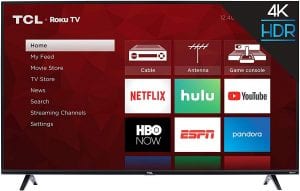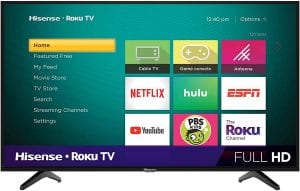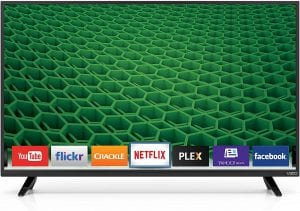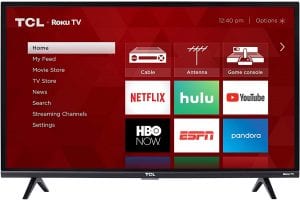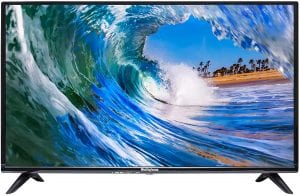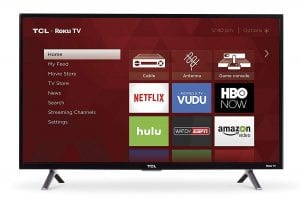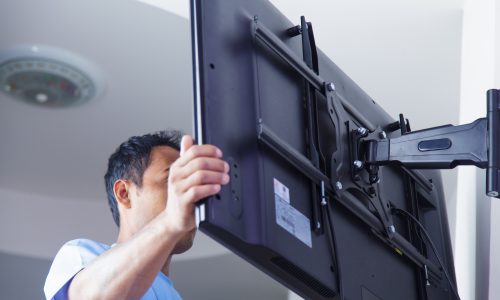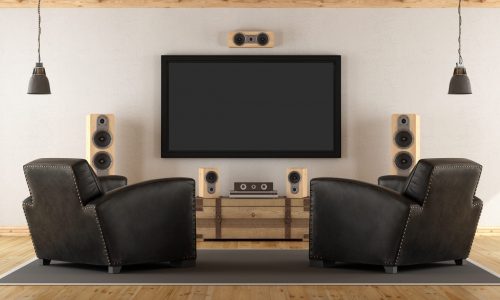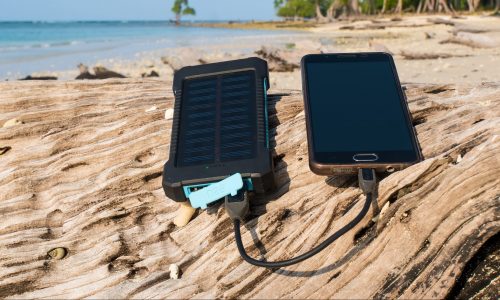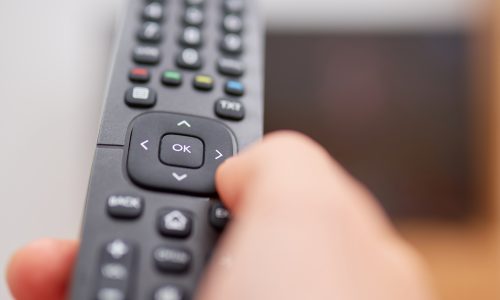The Best TVs Under $300
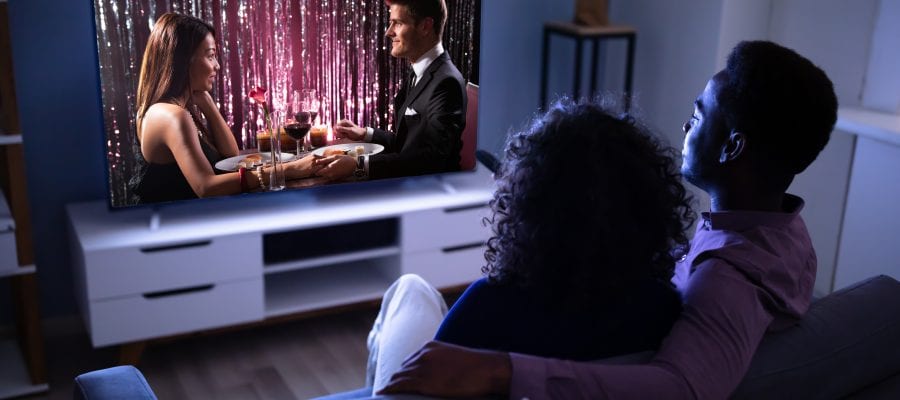
Our Review Process
Don't Waste Your Money is focused on helping you make the best purchasing decision. Our team of experts spends hundreds of hours analyzing, testing, and researching products so you don't have to. Learn more.
Our Picks For The Top Cheap TVs
This 50-inch TV has an easy-to-use interface that even technologically challenged individuals will love. In fact, this ROKU TV also comes with a powerful mobile app, so you can add channels from your phone. It's even compatible with Alexa and Google Assistant.
Sleek Modern DesignNot only is this 50-inch TV slim and elegant, but it also produces a stunning picture.
You'll get 1080p HD video and motion rate 120-image processing for a crisp, clear picture. Roku TV is built in to give you access to thousands of shows on streaming services. With this model, you can not only control your TV with the remote, but also with an iOS or Android device using the Roku app.
Vibrant and ImpressiveMotion rate 120-image processing keeps picture lag to a minimum to ensure fast-moving entertainment such as sporting events are clear.
This TV gives you access to internet apps via a built-in menu, letting you stream shows and movies using the most popular apps. With Clear Action 240, you get a 60 Hz refresh rate to provide top-quality images even when you're watching action films or sports. This TV features 1080p Full HD resolution to provide a clear picture every time.
LED BacklightThe LED backlight on this TV is full array, which means it distributes the light behind the entire screen for a consistent picture performance.
You'll get access to more than 5,000 streaming apps with this TV, which has built-in Roku technology. The slim profile means this TV looks great whether it's hanging on your wall or set up on a table. The free Roku smartphone app also lets you turn your mobile device into a remote to control your TV.
1080p HD VideoThis 1080p HD TV has a 120Hz refresh rate to ensure you're getting the best viewing experience, whether you're watching something or gaming.
Buying Guide
Buying a TV can be challenging, to say the least. It’s hard to measure one against another and, sometimes, it’s tough to determine which one has the best picture quality, even if you’re standing in front of a wall of different screens.
That’s where specs come in handy. By now, you’ve likely heard about the many benefits of a 4K Ultra HD TV. But you don’t always need a huge screen capable of providing movie theater-quality entertainment. Sometimes you just need a decent one for a bedroom or the kitchen. Or, perhaps you have a child going off to college who wants a TV for their dorm room or apartment. Another possibility is that you may simply not spend that much time watching television and, therefore, only need something basic for your main set.
The good news is that you can still find inexpensive TVs that pack impressive quality. While those 4K Ultra HD TVs have 8 million pixels and 8K TVs boast 33 million pixels, you’ll find the much more affordable 1080p and 720p LCD TVs still give you a great picture. You can find TVs in that range that provide an impressive display without spending much at all.
If you’re considering a 720p set, a distinction that has nearly 1 million pixels, look at the other built-in features that may boost performance. Many have their own innovative technologies that allow them to provide a crystal-clear display even with fewer pixels than their higher-priced counterparts.
You can also find some 1080p TVs, which have more than 2 million pixels, that build in technology that boost the display even further. You may also be able to find one of higher quality on sale if you want to buy during certain times of the year. TVs typically go on sale in the days leading up to the Super Bowl, Black Friday, around the holidays and in August, when college students are on the hunt for a TV.
Resolution isn’t the only thing to consider when looking at TV features. Many consumers today are looking for TVs that make it easy to connect to apps like Netflix and Hulu. You can find TVs that have streaming technologies built in, such as Roku, but any smart TV will allow you to at least access the most popular streaming services. If you are a cord-cutter, look for a TV that makes it easy to get to the content you prefer.
What to Look For
- Trusted brands are always best when it comes to electronics. Sure, you can save money buying a TV from a brand you’ve never heard of before, but some lower-end TVs can be defective. You usually can’t go wrong with brands like Samsung, Toshiba, LG, TCL and Sony, which tend to dominate the market.
- When it comes to video quality, resolution isn’t the only thing that matters. As valuable as that can be, it’s also important to pay attention to how the TV handles motion. Some displays struggle with keeping the quality high during sequences with a lot of movement on screen, for example. This makes watching sports, action movies and TV shows and gaming less pleasurable. Some TVs provide technology specifically geared toward displaying those types of scenes.
- Before you buy, consider where you’ll be setting up your TV. Will you be mounting it on a wall? If so, you’ll need a wall mount, which likely will be sold separately. If you’ll be setting it on a cabinet or table, make sure it comes with sturdy legs or a base that will keep it stable.
- Emphasis is usually placed on the size of the screen itself. But the thickness of the TV also comes into play, particularly if you’ll be hanging it. Many of today’s TVs feature a slim profile for that very reason.
- One of the most important factors when buying a TV today is access to content. If you’ll be connecting it to a cable or satellite box, you’ll need an HDMI port, which every high-definition TV will have. However, you may later also want to use a second HDMI port, whether to connect it to an audio receiver, gaming console or Blu-ray player. But if you stream, you’ll want a TV that can connect to your home Wi-Fi. Many TVs make this whole process easy, building in an app like Roku to give you access to thousands of streaming subscription options.
- Keep in mind that even if you buy a Smart TV or one that includes Roku, you’ll still need to subscribe to the various apps that offer streaming. The app that connects you to those services doesn’t charge a fee, but to get to content on Netflix, Hulu, Amazon Prime and those like it, you’ll need a subscription with each of those services, if you don’t have one already.
- If you find it difficult to run searches using only a TV remote, you’ll probably want to find one that offers voice controls. This technology allows you to simply press a button, or use a hands-free voice prompt, and say whatever text you want to search.
- Some TVs also have Bluetooth built in and let you download an app to control your TV using a smartphone or tablet.
- You may also consider investing in a soundbar or home-audio system that will provide a better viewing experience, especially if you plan to watch a lot of titles with high-quality sound effects.

